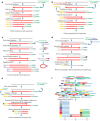Single-cell sequencing and tumorigenesis: improved understanding of tumor evolution and metastasis
- PMID: 28405930
- PMCID: PMC5389955
- DOI: 10.1186/s40169-017-0145-6
Single-cell sequencing and tumorigenesis: improved understanding of tumor evolution and metastasis
Abstract
Extensive genomic and transcriptomic heterogeneity in human cancer often negatively impacts treatment efficacy and survival, thus posing a significant ongoing challenge for modern treatment regimens. State-of-the-art DNA- and RNA-sequencing methods now provide high-resolution genomic and gene expression portraits of individual cells, facilitating the study of complex molecular heterogeneity in cancer. Important developments in single-cell sequencing (SCS) technologies over the past 5 years provide numerous advantages over traditional sequencing methods for understanding the complexity of carcinogenesis, but significant hurdles must be overcome before SCS can be clinically useful. In this review, we: (1) highlight current methodologies and recent technological advances for isolating single cells, single-cell whole-genome and whole-transcriptome amplification using minute amounts of nucleic acids, and SCS, (2) summarize research investigating molecular heterogeneity at the genomic and transcriptomic levels and how this heterogeneity affects clonal evolution and metastasis, and (3) discuss the promise for integrating SCS in the clinical care arena for improved patient care.
Keywords: Cancer; Cancer stem cells; Circulating tumor cells; Single-cell sequencing; Tumor heterogeneity; Whole-genome amplification.
Figures




References
-
- Allison KH, Sledge GW. Heterogeneity and cancer. Oncology (Williston Park). 2014;28:772–778. - PubMed
Publication types
LinkOut - more resources
Full Text Sources
Other Literature Sources
Miscellaneous
